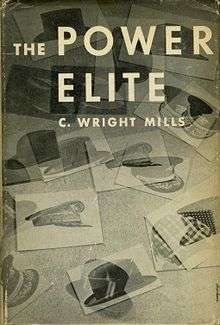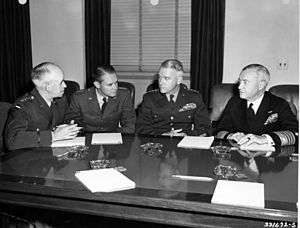The Power Elite

(publ. Oxford University Press)
The Power Elite is a 1956 book by sociologist C. Wright Mills, in which Mills calls attention to the interwoven interests of the leaders of the military, corporate, and political elements of society and suggests that the ordinary citizen is a relatively powerless subject of manipulation by those entities.
Background
The book is something of a counterpart of Mills' 1951 work, White Collar: The American Middle Classes, which examines the then-growing role of middle managers in American society. A main inspiration for the book was Franz Leopold Neumann's book Behemoth: The Structure and Practice of National Socialism in 1942, a study of how Nazism came into a position of power in a democratic state like Germany. Behemoth had a major impact on Mills and he claimed that Behemoth had given him the "tools to grasp and analyse the entire total structure and as a warning of what could happen in a modern capitalist democracy".[1]
Summary

According to Mills, the eponymous "power elite" are those that occupy the dominant positions, in the dominant institutions (military, economic and political) of a dominant country, and their decisions (or lack of decisions) have enormous consequences, not only for the U.S. population but, "the underlying populations of the world." The institutions which they head, Mills posits, are a triumvirate of groups that have succeeded weaker predecessors: (1) "two or three hundred giant corporations" which have replaced the traditional agrarian and craft economy, (2) a strong federal political order that has inherited power from "a decentralized set of several dozen states" and "now enters into each and every cranny of the social structure," and (3) the military establishment, formerly an object of "distrust fed by state militia," but now an entity with "all the grim and clumsy efficiency of a sprawling bureaucratic domain."
Importantly, and in distinction from modern American conspiracy theory, Mills explains that the elite themselves may not be aware of their status as an elite, noting that "often they are uncertain about their roles" and "without conscious effort, they absorb the aspiration to be ... The Ones Who Decide." Nonetheless, he sees them as a quasi-hereditary caste. The members of the power elite, according to Mills, often enter into positions of societal prominence through educations obtained at eastern establishment universities like Harvard, Princeton, and Yale. But, Mills notes, "Harvard or Yale or Princeton is not enough ... the point is not Harvard, but which Harvard?" Mills identifies two classes of Ivy League alumni, those initiated into an upper echelon fraternity or final club, such as Porcellian and Fly Club, and those who are not. Those so initiated, Mills continues, receive their invitations based on social links first established in elite private preparatory academies, where they are enrolled as part of antebellum family traditions. In this manner, the mantle of the elite generally passes through families.
The resulting elites, who control the three dominant institutions (military, economy and political system) can be generally grouped into one of six types, according to Mills:
- the "Metropolitan 400" - members of historically notable local families in the principal American cities, generally represented on the Social Register
- "Celebrities" - prominent entertainers and media personalities
- the "Chief Executives" - presidents and CEOs of the most important companies within each industrial sector
- the "Corporate Rich" - major landowners and corporate shareholders
- the "Warlords" - senior military officers, most importantly the Joint Chiefs of Staff
- the "Political Directorate" - "fifty-odd men of the executive branch" of the U.S. federal government, including the senior leadership in the Executive Office of the President, sometimes variously drawn from elected officials of the Democratic and Republican parties but usually professional government bureaucrats
Reception and criticism
Commenting on The Power Elite, Arthur M. Schlesinger, Jr. derisively said "I look forward to the time when Mr. Mills hands back his prophet's robes and settles down to being a sociologist again."[2] Adolf Berle noted the book contained "an uncomfortable degree of truth," but that Mills presented "an angry cartoon, not a serious picture,"[2] while Dennis Wrong described The Power Elite as "an uneven blend of journalism, sociology, and moral indignation."[3] A review of the book in the Louisiana Law Review bemoaned that the "practical danger of Mr. Mills' pessimistic interpretation of the current situation is that his readers will concentrate on answering his prejudicial assertions rather than ponder the results of his really formidable research."[4]
Nonetheless, consideration of the book has become moderately more favorable over time. In 2006 G. William Domhoff wrote "Mills looks even better than he did 50 years ago."[5] Mills' biographer, John Summers, while admitting that The Power Elite was "vulnerable to the charge of conspiracy-mongering" declared that its historical value "seems assured."[2]
See also
- Power (social and political)
- Military-industrial complex
- New Left
- Social alienation
- Mass society
- Elite theory
- Iron law of oligarchy
References
- ↑ C.Wright Mills: Power, Politics and People, (New York, 1963 p.174)
- 1 2 3 Summers, John (14 May 2006). "The Deciders". New York Times. Retrieved 14 February 2014.
- ↑ Wrong, Dennis (September 1956). "The Power Elite, by C. Wright Mills". Commentary Magazine. Retrieved 14 February 2014.
- ↑ Woodard, Calvin (December 1956). "THE POWER ELITE, by C. Wright Mills". Louisiana Law Review. Retrieved 14 February 2014.
- ↑ Wrong, Dennis (2006). "Mills's The Power Elite, 50 Years Later". Contemporary Sociology.
External links
- C.W Mills,Structure of Power in American Society,British Journal of Socoiology,Vol.9.No.1 1958
- C. Wright Mills,About F. Neumanns study Structure of Nazi Germany in Power, Politics and People
- A Mills Revival? by S .Aronowitz
- C.Wright Mills, On Intellectual Craftsmanship from The Sociological Imagination, How Power Elite was made
- Sociology-Congress in Köln 2000 workshop: C. Wright Mills and his Power Elite: Actuality today?
- Art inspired by The Power Elite